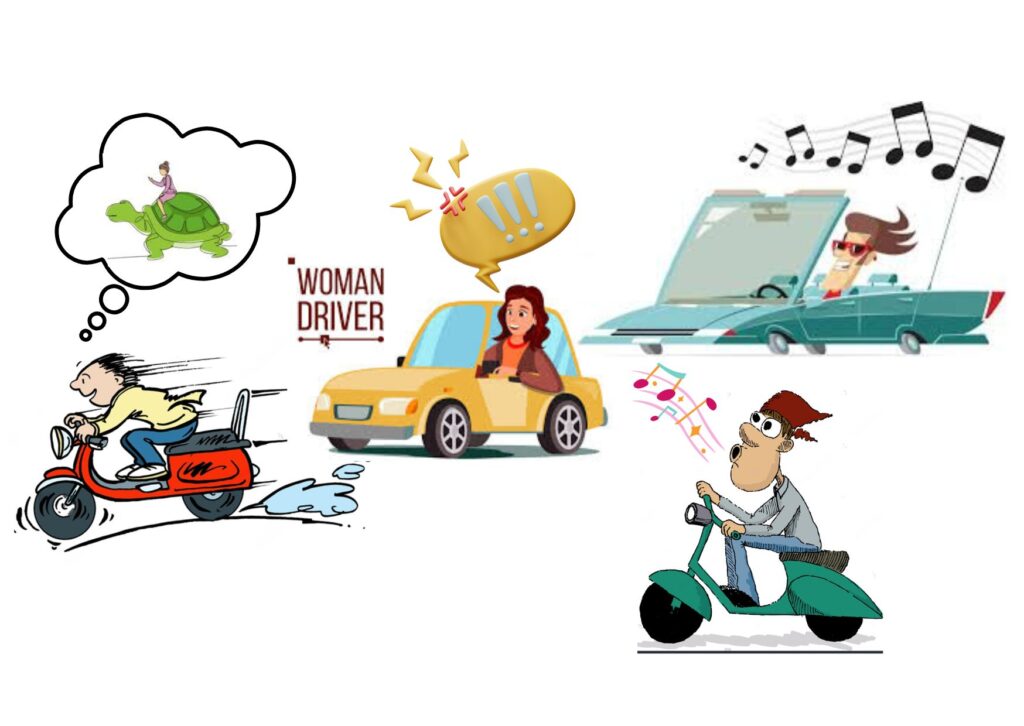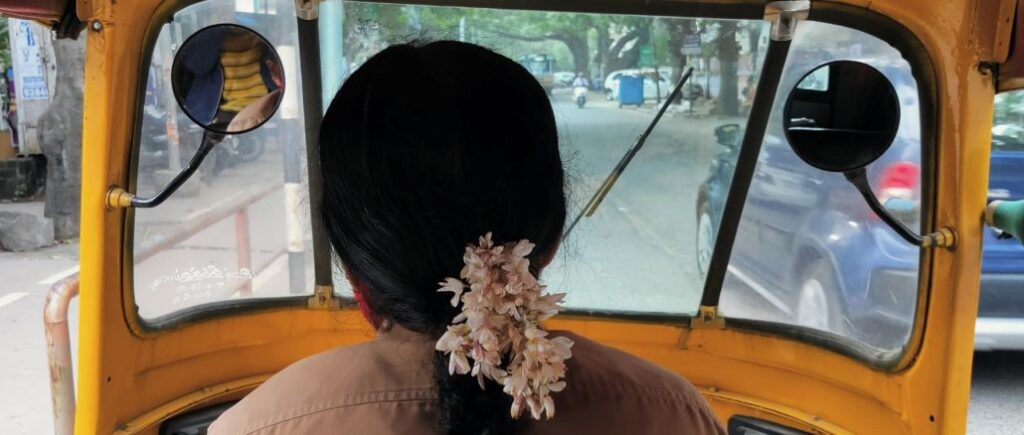Women Driving Winds Of Change
One afternoon I was driving my car for an errand. I was enjoying the drive alone on the beautiful stretch of a road flanked by tall trees. The monsoon rains had metamorphosed the vegetation all around into a verdant paradise. The rhythmic pitter-patter sound of raindrops on my windshield was music to my ears.
Suddenly, my peace was disrupted by a loud and raucous noise that could be equated to the roar of two aircraft. I peeped out of my window to check the skies for the aircraft but could not see much due to the rich foliage of trees. There was not much traffic on the road and whatever was there was very much in order. When I checked my rear-view mirror, I saw a thick cloud of black smoke billowing in the air from a moving object coming in my direction and the harsh noise also increased. The air and noise pollution were annoying everyone on the road. As the moving object came closer, I realised that it was a scooter which probably had a clogged air filter and no silencer.
As the scooter approached nearer, I realized that the rider was a young boy in his late teens who was riding at full throttle and in a rash manner. Very soon, the scooter was next to me and the rider was a lanky lad who had patches of grease all over his body and clothes. This indicated that he was a scooter mechanic, maybe an intern who took some moments off from his work in the name of testing and came out for a joyride on his new toy. The moment he looked at me, he slowed his scooter with a screeching sound and his eyes sparkled. From his lip movement, I could make out that he whistled at me but the sound of it got muffled in the din of his scooter. I was taken aback for a moment and wondered if I still looked so young. The next thing I saw was that he started showing off stunts on his scooter in front of my car and now and then kept looking back at me to check my reaction. I did not show my exasperation but feigned a smile. He was not letting me cross him and I was forced to maintain a low speed behind him. His actions reminded me of that irksome fly that keeps whirring around our faces, driving us crazy, and swatting it seems to be the only aim in our life at that moment.

Amidst all this drama, a car behind me kept continuously honking. I had to maneuver my car a bit to let the honking car pass by. As I juggled, this car, which was full to its capacity with young boys came near mine. It blared the latest Bollywood music and the occupants glared at me, making me uncomfortable. I heard one of the youngsters shouting at me, “Madam, if you do not know how to drive, then sit at home” while the other boys heehawed and thankfully, they sped away. The numbers on their number plate looked more like BOSS was embossed. I was speechless hearing their insensitive remark and wanted to tell them that I learned to drive when they may not be even born. Ignoring the comments, I maintained a straight face and as soon as I got an opportunity to cross the scooter irritant, I sped away – probably leaving him heartbroken!!
These incidents which happened with me on that particular day are so common with most of the women while driving on Indian roads. It is not every day that it happens to this extent, but women drivers do experience subtle eve-teasing irrespective of age or have to hear sexist slurs for their driving skills. This is morally upsetting and appalling in this era when we are talking about gender equality. I do not completely blame these youngsters whom I ran into for their scornful remarks or act towards me. It is anyway a globally believed myth that women are bad and lousy drivers. Women have been driving nations, businesses, and aircraft but when it comes to women driving a car on the road, it becomes a ludicrous subject for men. Our worldwide web is also full of jokes, memes, and slurs about women drivers. Are we so bad at it?
This myth about women drivers may have its roots about 100 years ago when the patriarchal society was very strong and women were considered to be inferior in many ways. Hence, driving was considered to be a male forte. From a young age, boys were encouraged to play with toy cars which brought in familiarity and hence developed higher confidence while driving as adults. With changing times, as women took up driving mostly out of necessity, men must have felt threatened. Forming the stereotype that women are bad drivers must have helped in fanning their huge male ego. But in today’s age when there is so much awareness and talk about gender equality and we also see so many women driving, this stereotype sounds absurd.
The good news for women is that the picture is not as gloomy as men have made it to appear. If we are to believe the statistics, then women generally emerge as more cautious, responsible, and safer drivers than men in day-to-day driving in most parts of the world. They avoid rash driving, over-speeding, and road rage and are normally steady. Women meticulously follow traffic rules and wear helmets and seatbelts. As per research, women exceed speed limits 12% less than men. They do not unnecessarily like to take risks of overtaking or whizzing between the narrow gaps of two buses with a margin of a few inches. Research shows that in comparison to women, 80% of motoring offenses are committed by male drivers, and more men are caught for DUI (driving under the influence) offenses. Most of the fatal accidents around the world have the involvement of male drivers and they prove to be more expensive for insurance companies. Statistically, no proof supports the idea that men are better drivers than women.
It is heartening to see that the tribe of women drivers is growing in number and at a faster rate than men. The number of women drivers grew by 23 percent in India between 1995 and 2010, says a study. According to Statista, out of 10.5 million new valid driving licenses issued in India in 2019 (latest data), 14.9% of driving licenses were issued to women. Otherwise, also, we can see more women driving independently now compared to a few decades ago. These days women are learning to drive as soon as they attain the driving age. Since the Indian economy is doing well and most of the families have more than one car, it helps young women to practice driving and their reflexes towards road traffic are developing early on. Hence, Generation Z is more proficient compared to the previous generations of women drivers.
This is a positive change happening in society and talks volumes about women’s empowerment. Driving helps women in being self-reliant, boosts self-confidence, and gives a sense of flexibility, security, privacy, and freedom. When women are mobile, their lives become very convenient, they are not dependent on anyone and can steer their families towards development and well-being.
Women are gradually breaking gender stereotypes by entering into several male-dominated professions. Many women have gained control over the steering wheel professionally by driving commercial buses, trucks, cabs, forklift operators, ambulances, and autos, especially in urban areas. Whenever they are behind the steering wheel of a commercial vehicle, they become the cynosure of all eyes on the road. Many private firms and NGOs are encouraging and training women from underprivileged backgrounds to drive. Initially, there were reservations about employing women drivers but now schools, hospitals, and other organizations are recruiting women for driver’s jobs. This is a niche area for women with a lot of opportunities in transport jobs. People want women drivers for the safety of their children, elderly people, and women of course. However, gender biases and many other challenges still exist in this profession too. Supportive government policies, creating a conducive working environment, and sensitizing the eco-system for commercial women drivers are the need of the hour.

Image source – Citizen Matters
Driving is a life skill that should be honed by all women. Society should encourage women to be mobile and do their own things instead of relying on the male folk of their families to transport them. Mobility is achieved not only by driving a car but can be attained even by riding a bicycle or whatever vehicle is affordable. Along with driving or riding a vehicle, women should also learn a host of other skills like maintaining the vehicle and parking responsibly. Also, it is everyone’s duty, irrespective of gender to drive or ride responsibly and keep all road users safe.

–Nivedita Chitnis, a writer and editor, has contributed to co-authoring books as well as writing for Indian newspapers.









